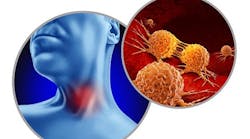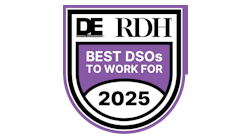A few years ago, there were certain words that became a part of our everyday vocabulary: Shutdown, social distancing, remote, mandatory, transmission, quarantine, virtual, and isolation. Many would describe 2020 and 2021 as lonely, uneasy years as we were required to physically separate ourselves from our routines, families, and friends to protect our health and well-being.
We were reminded very early on that humans are not meant to live in isolation, and we saw a major shift from physical to virtual connection by way of social media, FaceTime, and Zoom. The federal emergency for the COVID-19 pandemic has officially ended, but our global culture still feels the powerful aftershock from billions of people who were forced to live in seclusion—starved of physical touch, eye contact, and face-to-face conversation.
In the dental industry, we've experienced changes as well. The consensus among clinicians in popular online forums is that patients are perceived to be more difficult to communicate with, less dependable in honoring their appointment times, less inclined to accept treatment, and less appreciative of the oral health-care services they receive than they were years ago. Many practices are still struggling to recruit and retain quality team members during a continued nationwide staffing shortage, which negatively affects the level of trust and respect given by their patients.
Despite elevated infection control measures and technological advancements such as 3D printing, programs guided by artificial intelligence, and digital scanning, something still seems to be missing from the overall patient experience. While we can always benefit from offering additional services and education, perhaps the approach is what truly needs to change so that we can reconnect with the humans who sit in our operatory chairs—focusing more on relationships and less on the minor details of the visit.
You might also want to read: Patient-centered to person-centered care: How do we get there?
TMI: Too much information
One of the biggest issues we face as a modern-day society is a constant state of information overload, thanks to things like online tracking, cookies, virtual assistant apps, and social media algorithms. Because our online experience is expertly curated to continually provide personalized content that engineers think we want, many individuals become out of touch with their own opinions and beliefs.1
What’s more, people can’t always tell fact from fiction, as even “reliable” sources can mislead us into believing what is not the complete truth. This phenomenon has led us to ignore our intuition—an instinctual awareness that guides our decision-making and allows us to live our lives with direction and clarity. Dental professionals must also possess this important skill to provide patients with the best clinical experience, yet it is rarely utilized. This is where the concept of intuitive patient care was founded.
Is intuition scientific?
For centuries, intuition has been recognized as a real human experience, but difficult to describe scientifically. Philosophers describe it as “the power of obtaining knowledge that cannot be acquired either by inference or observation, by reason or experience.”2 Some may call this a “hunch” or a “gut feeling.” How do you theorize or measure gut feelings? In 2016, Lufityanto and others did just that.3
In a controlled experiment, groups of college students were shown a series of black-and-white images on one side of a computer screen, while the other side displayed a bright, flashing colored square. At times, researchers snuck in subliminal images to stimulate intuition among the participants. They saw that participants who were shown positive subliminal images performed tasks better than those who were shown negative subliminal images. It was evident that the subliminal images stimulated the students’ intuition, triggering emotional decisions that occurred too quickly to be considered conscious. The participants who used their intuition in a positive environment during the study generally made quicker, more accurate, confident choices than those who solely relied on their own logic and reason.
Applying intuition to patient care
In health care, we are taught to think, talk, and act based on evidence when it concerns our patients. With all the information, products, and trends we are exposed to as clinicians, it can be difficult to know what’s safe and effective. Each of us is tasked with the responsibility of performing our own research to make sure that what we recommend to our patients is truly in their best interest.
In some circumstances, however, evidence may be lacking—leaving us unsure of what is the most logical solution to the problem facing the patient. This can especially be true when caring for a patient who is exhibiting strong emotions such as fear, anger, confusion, or even indifference. Pain is another factor that can severely complicate proper patient management and require more from the provider than simple logic.
Tuning in to our intuitive side to respond to the human dilemmas we face every day in the operatory can bridge the gap between evidence and emotion, but how can we do that? An interesting finding from the study performed by Lufityanto and his colleagues showed that participants who did not readily trust their intuition at the beginning of the experiment had the ability to increasingly utilize their intuition over time, which in turn improved their decision-making. Here are some simple ways to develop your intuition:
- Designate a time during the day to separate yourself from the information overload found on your device and focus on a creative flow that comes from within (e.g., drawing, poetry, painting, music, yoga, hobbies).
- Consider keeping a reflective journal, making notes about the hunches and gut feelings you experience throughout the day.
- Practice mindfulness techniques such as meditation, breath work, body scans, and being present in your current surroundings.
The more intentional we become about leaning on our intuition, the more we will be willing to trust it.
Our interactions with those around us can also help to build our practice of intuitive patient care. Treating our patients with empathy enables us to feel and share what they are experiencing from their perspective. When we are focused on how and why our patients are feeling in relation to the care we’re providing, it immediately activates an emotional connection that is fueled by intuition.
Active listening requires us to be aware of both the verbal and nonverbal communication our patients share and stimulates intuition. Being open-minded and curious about our patients’ beliefs and lifestyles allows us to loosen our grip on the logic that we’re familiar with and creates space for intuition.
Similarly, self-regulation requires us to manage our own responses to the stimuli we are confronted with so we can remain receptive and understanding to people and situations that might initially cause offense or frustration. Lastly, intuition can be strengthened by being willing to meet the patient where they are after considering factors such as their dental IQ, finances, physical abilities, anxiety, and pain—while weighing all possible treatment options to attain the best possible outcome.
Treating patients in a postpandemic world can be challenging. Our population is still recovering from the effects of being forced to live life virtually while being inundated with information on all fronts. Technology continues to advance, and artificial intelligence and chatbots—while useful in many modern-day applications—pose a potential threat to our instinctual awareness and gut feelings.
Intuition allows clinicians to connect with patients in ways that science and logic do not. Intuitive patient care is not meant to replace evidence-based practice, but rather, enhance it. By relating to our patients on a human level, we are sure to witness a surge in patient satisfaction, compliance, and most importantly, improved health.
Editor's note: This article appeared in the August 2023 print edition of RDH magazine. Dental hygienists in North America are eligible for a complimentary print subscription. Sign up here.
References
- Cozolino L, Drulis C, Samuelson C. The science of intuition. Psychology Today. October 20, 2021. Accessed May 23, 2023. https://www.psychologytoday.com/us/blog/executive-functioning/202110/the-science-intuition.
- Britannica, The Editors of Encyclopaedia. Intuition. Encyclopedia Britannica. Mar. 4, 2012. https://www.britannica.com/topic/intuition. Accessed May 31, 2023.
- Lufityanto G, Donkin C, Pearson J. Measuring intuition: Nonconscious emotional information boosts decision accuracy and confidence. Psychol Sci. 2016;27(5):622-634. doi:10.1177/0956797616629403






